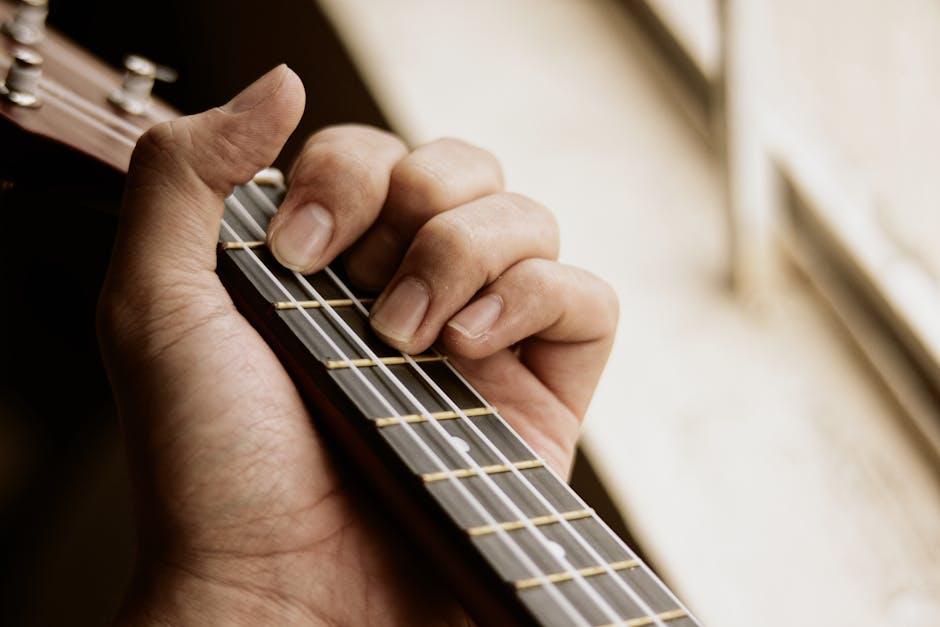Are you tired of feeling like you’re playing a game of musical hide and seek every time you pick up your guitar? Do you find yourself lost in a sea of frets, desperately trying to remember where in the world that elusive G# is hiding? Fear not, fellow fretboard fugitives! In this article, we will explore the wild and wacky world of mastering fretboard fluency. Say goodbye to musical confusion and hello to a harmonious relationship with your guitar. So grab your trusty six-string, buckle up, and get ready to embark on a fret-tastic journey towards fretboard mastery!
Contents
- 1 Understanding the Foundation: The Layout of the Guitar Fretboard
- 2 Developing a Roadmap: Visualizing Note Locations
- 3 Embracing Muscle Memory: Repetitive Practice for Retention
- 4 Unlocking the CAGED System: A Pathway to Fretboard Mastery
- 5
- 6 Leveraging Technology: Using Apps and Tools for Enhanced Learning
- 7 Cultivating Patience and Discipline: The Key to Long-Term Success in Fretboard Fluency
- 8 FAQs
- 9 Time to Rock On!
Understanding the Foundation: The Layout of the Guitar Fretboard
Alright, buckle up folks! We’re about to dive into the mysterious world of the guitar fretboard. Picture this: a long, slender neck with thin metal bars running across it like a maze. Each bar, known as a fret, represents a different note. It’s basically like playing a musical game of hopscotch!
Now, let’s talk about those six strings that run parallel to the frets. These bad boys are responsible for producing the glorious sounds that make your heart sing (or cry, depending on your skill level). From the low E string to the high E string, each one has its own unique personality and range of notes.
As you move up the fretboard towards the body of the guitar, the pitch of the notes gets higher and higher. It’s like climbing a musical mountain, with each fret acting as a stepping stone to reach new heights of musical genius. Just remember, don’t look down – unless you want to see the pile of broken guitar picks you’ve accumulated over the years.
So there you have it, the layout of the guitar fretboard demystified! Now go forth, young grasshoppers, and conquer the fretboard with your newfound knowledge. Who knows, maybe one day you’ll be shredding like a rock god or serenading your significant other with a sweet ballad. The possibilities are endless – just like the notes on the fretboard.

Developing a Roadmap: Visualizing Note Locations
So you’ve got a ton of notes scattered across various platforms and devices – it’s like a tornado swept through your brain and deposited little scraps of information everywhere. Fear not, dear reader, for we are here to help you corral those wayward notes and create a roadmap to organization bliss.
First things first, let’s gather all of those notes into one central location. Whether you use a physical notebook, a digital note-taking app, or good old-fashioned sticky notes, round them all up and bring them to the organizing party. Think of it as a notes intervention – those little guys have been partying too hard without any supervision.
Next, let’s start visualizing where each note belongs in the grand scheme of things. Create categories or folders for different topics, projects, or ideas. Use color-coding or symbols to differentiate between urgent notes, ideas for future projects, or random thoughts that may or may not make any sense. The more visually appealing your roadmap is, the more likely you are to actually use it.
Now comes the fun part – arranging your notes within each category or folder. This is like playing a game of Tetris, but with way more pieces and way less stress. Make sure to prioritize your notes based on importance, relevance, or sheer randomness – there are no rules when it comes to organizing your thoughts. Embrace the chaos and let your creativity flow!
Embracing Muscle Memory: Repetitive Practice for Retention
Have you ever seen a squirrel diligently practicing how to climb a tree over and over again? No? Well, that’s because they were born with that muscle memory! Us humans, on the other hand, have to work a little harder at it. But fear not, my friends, with repetitive practice, we can train our muscles to remember all sorts of movements and actions.
Think of muscle memory like your brain’s personal trainer – it keeps track of all the hard work you’ve put in and helps you perform tasks with ease. Whether you’re learning a new dance routine, perfecting your tennis swing, or even just typing on a keyboard, repetitive practice is the key to retention. The more you practice, the stronger that muscle memory becomes, making tasks feel like second nature.
So, next time you find yourself struggling with a new skill, don’t get discouraged! Embrace the power of muscle memory and keep practicing until it becomes as easy as riding a bike (which, by the way, is a perfect example of muscle memory at work!). With determination, dedication, and a whole lot of repetition, you’ll be amazed at how quickly your muscles start to remember and retain all those movements.
- Repetitive practice is like hitting the “save” button for your muscles.
- Don’t be afraid to make mistakes – they’re all part of the learning process!
- Consistency is key – try to practice a little bit every day to solidify that muscle memory.

Unlocking the CAGED System: A Pathway to Fretboard Mastery
So, you’ve been jamming away on your guitar, but still feel like you’re trapped in a musical cage? Fear not, dear guitarist! The CAGED system is here to set you free and unlock the secrets of the fretboard!
First things first, let’s break down what CAGED actually stands for:
- C – C Major chord shape
- A - A Major chord shape
- G – G Major chord shape
- E – E Major chord shape
- D – D Major chord shape
Now that you know the basics, it’s time to start incorporating this system into your playing. Here are a few tips to help you on your journey to fretboard mastery:
- Practice transitioning between the CAGED chord shapes to get comfortable moving around the fretboard.
- Use the CAGED system to visualize scales and arpeggios in different positions.
- Experiment with playing chord progressions using the CAGED shapes to add variety to your playing.
Remember, mastering the CAGED system won’t happen overnight, but with dedication and practice, you’ll soon be wowing audiences with your newfound fretboard freedom!

chords-practical-application-of-fretboard-knowledge”>Incorporating Scales and Chords: Practical Application of Fretboard Knowledge
Have you ever looked at your guitar fretboard and felt like you were staring at a complicated maze with no way out? Well, fear not! We’re here to help you navigate through the chaos and master the art of incorporating scales and chords into your playing.
First things first, let’s talk about scales. Scales are like the building blocks of music, and knowing your scales is crucial for understanding how chords are constructed. So, grab your trusty guitar and start practicing those scales like there’s no tomorrow!
Now, let’s move on to chords. Chords are like the spices that add flavor to your musical dish. Knowing how to play a variety of chords will take your playing to the next level. So, start experimenting with different chord shapes and voicings to spice up your playing.
Remember, the key to mastering the fretboard is practice, practice, and more practice! So, grab your guitar, dive in, and before you know it, you’ll be incorporating scales and chords like a pro. And who knows, maybe one day you’ll be the next guitar virtuoso everyone is talking about!
Leveraging Technology: Using Apps and Tools for Enhanced Learning
Let’s face it, learning can be a drag sometimes. But fear not, dear readers! There are a plethora of apps and tools out there that can make the learning experience a breeze. Say goodbye to traditional textbooks and hello to the exciting world of educational technology!
With the power of apps like Kahoot, learning has never been more interactive. Forget about boring lectures and boring textbooks – Kahoot turns learning into a game! Compete against your classmates in quizzes and challenges, and watch as your knowledge grows while having a blast.
And who needs a boring old notepad when you have Evernote at your fingertips? Keep track of all your notes, thoughts, and ideas in one place, and access them from any device. No more losing track of important information – Evernote has got your back!
But wait, there’s more! Quizlet is here to revolutionize the way you study. Flashcards? That’s so last century. With Quizlet, you can create custom study sets, play fun games, and even compete in live study sessions with friends. Learning has never been so entertaining!
Cultivating Patience and Discipline: The Key to Long-Term Success in Fretboard Fluency
Mastering the fretboard is no easy feat. It requires a great deal of patience and discipline. You can’t expect to become a guitar virtuoso overnight. But fear not, with the right mindset and approach, you can achieve long-term success in fretboard fluency.
First and foremost, it’s important to establish a solid practice routine. Dedicate a set amount of time each day to practicing scales, chords, and arpeggios. Consistency is key here. Remember, Rome wasn’t built in a day, and neither will your fretboard fluency.
Another crucial aspect of cultivating patience and discipline is setting realistic goals for yourself. Don’t expect to be shredding like Steve Vai after a week of practice. Take it one step at a time, and celebrate the small victories along the way. Progress may be slow, but it’s still progress!
Lastly, don’t be afraid to seek guidance from a qualified instructor. A good teacher can provide you with valuable feedback and insights that can help you improve much faster. Remember, there’s no shame in asking for help. In fact, it shows true dedication and commitment to your craft. So keep at it, stay focused, and before you know it, you’ll be rocking out like a true guitar hero!
FAQs
Why is it important to learn all the notes on the guitar fretboard?
Well, imagine trying to navigate a maze without a map. That’s what playing the guitar without knowing the fretboard notes feels like – confusing and frustrating. Knowing the notes helps you understand music theory, improvise with ease, and impress your friends with your guitar prowess.
What are some techniques for efficiently learning guitar notes?
One fun technique is creating mnemonic devices to remember the order of notes on each string. For example, “Eddie Ate Dynamite, Good Bye Eddie” for the EADGBE tuning. Another helpful technique is practicing scales and arpeggios up and down the fretboard, which hones your muscle memory and sharpens your note recognition skills.
How can I improve my fretboard fluency without getting bored?
Who says learning can’t be fun? Spice things up by turning note recognition into a game. Quiz yourself or play fretboard bingo with a friend. You can also learn songs by ear, using your newfound knowledge of the fretboard to decipher those tricky guitar solos.
Is it possible to master fretboard fluency in a short amount of time?
Well, Rome wasn’t built in a day - and neither is fretboard fluency. It takes time, dedication, and practice. But with the right techniques and a bit of perseverance, you’ll be shredding like a pro in no time!
Time to Rock On!
Congratulations, you are on your way to becoming a fretboard genius! By implementing the techniques discussed in this article, you will be able to navigate the guitar with ease and confidence. Remember to practice consistently and have fun exploring the endless possibilities that mastering fretboard fluency can bring to your playing. Now go forth, jam out, and impress all your friends with your newfound guitar knowledge. Keep strummin’!



